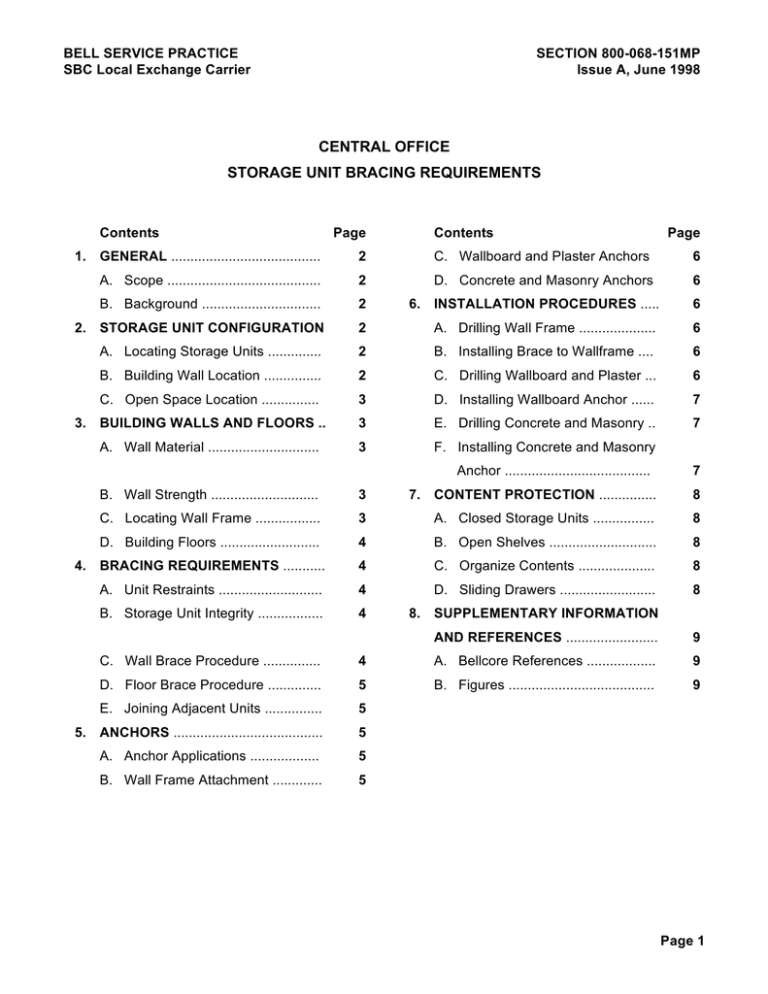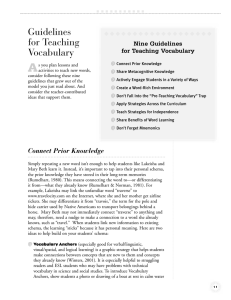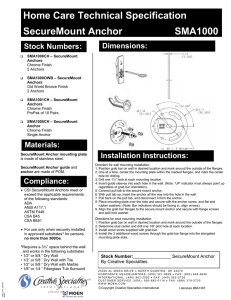CENTRAL OFFICE STORAGE UNIT BRACING REQUIREMENTS
advertisement

BELL SERVICE PRACTICE SBC Local Exchange Carrier SECTION 800-068-151MP Issue A, June 1998 CENTRAL OFFICE STORAGE UNIT BRACING REQUIREMENTS Contents 1. 2. 3. Page Contents GENERAL ....................................... 2 C. Wallboard and Plaster Anchors 6 A. Scope ........................................ 2 D. Concrete and Masonry Anchors 6 B. Background ............................... 2 INSTALLATION PROCEDURES ..... 6 STORAGE UNIT CONFIGURATION 2 A. Drilling Wall Frame .................... 6 A. Locating Storage Units .............. 2 B. Installing Brace to Wallframe .... 6 B. Building Wall Location ............... 2 C. Drilling Wallboard and Plaster ... 6 C. Open Space Location ............... 3 D. Installing Wallboard Anchor ...... 7 BUILDING WALLS AND FLOORS .. 3 E. Drilling Concrete and Masonry .. 7 A. Wall Material ............................. 3 F. Installing Concrete and Masonry 6. Anchor ...................................... 4. 5. Page B. Wall Strength ............................ 3 C. Locating Wall Frame ................. 7. 7 CONTENT PROTECTION ............... 8 3 A. Closed Storage Units ................ 8 D. Building Floors .......................... 4 B. Open Shelves ............................ 8 BRACING REQUIREMENTS ........... 4 C. Organize Contents .................... 8 A. Unit Restraints ........................... 4 D. Sliding Drawers ......................... 8 B. Storage Unit Integrity ................. 4 8. SUPPLEMENTARY INFORMATION AND REFERENCES ........................ 9 C. Wall Brace Procedure ............... 4 A. Bellcore References .................. 9 D. Floor Brace Procedure .............. 5 B. Figures ...................................... 9 E. Joining Adjacent Units ............... 5 ANCHORS ....................................... 5 A. Anchor Applications .................. 5 B. Wall Frame Attachment ............. 5 Page 1 Iss. A, SECTION 800-068-151MP 1. GENERAL A. Scope 1.01 This document is issued to provide guidelines for supporting and bracing storage units located in Nevada Bell/Pacific Bell/Southwestern Bell buildings. Storage units include closed-door cabinets, lockers, bookcases, file cabinets and open shelving used to keep equipment, supplies, tools, documents, spare parts or personal items for future use. 1.02 Document rereleased as merged practice and renumbered from PBS-068-151PT to BSP 800068-151MP to incorporate requirements for Nevada Bell/Pacific Bell/Southwestern Bell. B. Background 1.03 Past experiences with storage units have created service and safety problems in telephone company buildings. Contents in storage units have fallen off shelves and been damaged. Storage units have overturned in earthquakes or when inadvertently impacted. 1.04 The guidelines are intended to provide methods for securing existing storage units to minimize personnel injury, equipment damage and service outage during normal use and in earthquakes. 1.05 The guidelines apply to storage units not originally designed with anchoring and bracing systems. Approved free standing storage units with floor anchoring provisions will not require bracing described in this document. 1.06 In Low Seismic Risk locations (Zones 0,1,2) it is recommended that storage units be restrained by methods described within this document to prevent inadvertent overturning of unit. Storage units may topple or overturn due to unbalanced weight stored within unit or shifting of weight from drawers, slides or from inadvertent impact to unit. In High Seismic Risk locations (Zones 3,4) it is required that storage units be restrained as described within this document. In addition to risks as in low seismic risk locations, ground movement of earthquakes increases risks of unit overturning. 2. STORAGE UNIT CONFIGURATION A. Locating Storage Units 2.01 Placements of storage units in buildings are dictated by their application, building configuration and available space. For securing storage units, install units against building walls to restrict unit movement and to provide bracing surfaces. Storage units located in open space are at greater risks for overturning. B. Building Wall Location 2.02 Storage units located against walls must have back directly to wall. Do not leave space between unit and wall, Figure 1 A. Adjacent units shall be placed with side panels flush against each other. Walls and adjacent units block units from movement. 2.03 Portable wall partition systems used in administrative areas are not capable of restraining storage units. Do not rely on partition system walls for securing storage units. Storage units placed in these areas are to be treated as open space located units. 2.04 Page 2 Storage units may be placed in front of building columns if braced to column. Columns must have secure flat surface for attachment of braces, Figure 1 C. Circular columns or hollow Iss. A, SECTION 800-068-151MP columns may not provide adequate bracing surface. In these cases, move unit against wall or group units and brace together. C. Open Space Location 2.05 Storage units placed in open space shall be grouped with other units, Figure 1 B. All units are to be placed with sides and backs flush to adjacent units. Locating a single unit in an open space is not recommended. Move lone unit to a location where it can be braced to a building wall. 3. BUILDING WALLS AND FLOORS A. Wall Material 3.01 Common interior wall materials are gypsum board, plaster, concrete, concrete block, brick and glass. Structural framing for wall materials may be wood or metal studs, wood lath with wire mesh, steel beams or reinforced concrete. 3.02 Walls may have covering or facing of masonite paneling, wall paper, wall board or plywood. The facing material will not support load of storage units and cannot be used for anchoring or bracing. Anchors must penetrate the facing and into wall frame for wall brace security. B. Wall Strength 3.03 Perimeter walls and load bearing walls normally have acceptable load carrying capacity for bracing storage units. Some interior walls are designed to partition space and not for supporting building loads. These non load-bearing walls have limited strength and heavily loaded storage units should not be attached to them. 3.04 Braces must be fastened to the wall framing whenever possible. Some walls may not have structural framing, i.e., plaster walls and concrete block walls. Wall braces fastened with toggle anchors are to be used only where wall framing is not accessible. C. Locating Wall Frame 3.05 Most wall frames are constructed of 2" x 4" wood studs or formed sheetmetal spaced 16 inches on center, Figure 2. Near corners, wall edges or where special reinforcement is required, the frame spacing may be less than 16 inches. In older buildings the studs may not be evenly spaced or may not be on 16" center. 3.06 Electronic and magnetic stud locators are available for locating wall framing. A typical electronic locator is manufactured by Zircon Corporation which detects varying density of wall material. LED's on the locator indicate when wall studs are approached. The magnetic stud finder locates the stud by detecting head of nails that have previously been placed or senses sheetmetal stud location. Both types of locators are available from hardware stores. Page 3 Iss. A, SECTION 800-068-151MP D. Building Floors 3.07 Floors in most equipment and administrative buildings are concrete. The normal thickness of the concrete will be 5 inches. Actual floor thickness at buildings varies between 4 to 7 inches. The floor will adequately support weight of all storage units and provide secure emplacement of floor anchors. 3.08 Floors are reinforced with steel rebars 1" to 3" beneath floor surface. Near load bearing walls and columns, there are usually lattices of reinforcement bars tying the floor to the building. If rebar is encountered during the drilling of anchor holes, do not cut rebar without approval of the building Facilities Engineer and without considering other alternatives. Relocating anchor should be examined as first alternative. 3.09 Building floor may be constructed of plywood sheets or wood planks over wood or steel joists. Anchoring to wood floors shall follow procedures for wall framing. Use wood lag bolts to fasten storage units to floor joists. 4. BRACING REQUIREMENTS A. Unit Restraints 4.01 All storage units shall be secured at least for one of the unit’s surface to a building wall or floor and for multiple units grouped, all units shall also be secured together through adjacent surfaces. 4.02 Units located against walls shall be braced by attachment to the wall and floor, Figure 3. The top of the unit is braced to the wall either through back panel or externally with steel angle. Base of unit is braced to building floor with steel angle. 4.03 Storage units located in open space shall be braced to the building floor, Figure 4. Unit is braced to building floor externally with angles at front face of base and back face of base. B. Storage Unit Integrity 4.04 Storage units must be inspected for structural integrity. Lean against the side of the unit with shoulders without tipping cabinet. If the unit resists sideways sway it is serviceable. If there is substantial leaning, more than two inches at the top, unit assembly bolts should be tightened, unit reinforced or unit replaced. C. Wall Brace Procedure 4.06 Fasten storage unit to wall from inside the back panel or unit structural members with two anchors per unit. The 7/16" diameter holes should be spaced to align with wall studs behind the unit and located towards top of unit. In units where access to the back panel may be difficult, external braces are required. 4.07 Storage units are braced externally with 1 - 1/2' x 1 - 1/2" x 3/16" thick steel angles cut to width of the unit, Figure 3A. Locate 7/16" diameter holes with angle to match wall stud location. Fasten the steel angle to the top of storage units with #12 hardware at 6 inch spacing. Drill 1/4" diameter holes for fasteners. Grouped storage units can be braced using one length of angle across all units. 4.08 Page 4 For back panel or external wall brace, reinforce the inside surface of unit panel with large diameter washers or a length of 1/8" thick steel plate at fastener locations. Iss. A, SECTION 800-068-151MP D. Floor Brace Procedure 4.09 Storage units are braced to building floor with steel angle, minimum 1 - 1/2" x 1 - 1/2" x 3/16" thick, Figure 3B. One leg of the angle shall be fastened to base with #12 hardware at six-inch spacing. Nut and washer should be placed inside of base. Fasten angle to floor with two (2) Hilti HDI 3/8" diameter drop in anchors. Grouped storage units can be braced using one length of angle across all units. 4.10 For units such as lockers and open shelves with legs instead of base assembly, individual angle brackets may be required at each leg. The angle bracket shall be fastened to leg with 3/8' capscrew and nut then anchored to floor with one (1) Hilti HDI 3/8" anchor. E. Joining Adjacent Units 4.11 All adjacent storage units shall be bolted together at side and/or back panels. Join adjacent units with #12 hardware at top and bottom of each adjoining panel, Figure 5A. For open shelf units, fasten to adjacent units at shelf supports only. Do not fasten to shelves only as shelves may not be positively attached to shelf supports. 4.12 Storage unit may not provide access to side or back panels. Attach units externally with flat steel strap, 1" x 1/8”, across the top and bottom of the units. The strap shall be attached at two places of each unit using #12 hardware. 4.13 Reinforce the inside surface of unit panel with large diameter washers or a length of 1/8" thick steel plate at fastener locations, Figure 5A. 5. ANCHORS A. Anchor Applications 5.01 Anchors are designed for use in specific materials. The manufacturer's recommendations for anchor application must be followed. 5.02 A minimum of two (2) wall anchors must be used for bracing each storage unit. One additional anchor is required where brace is not fastened to wall studs, as with toggle anchors. 5.03 A minimum of two (2) floor anchors must be used for bracing each storage unit. Open space located units require an additional angle for the back of the base and two (2) additional anchors. 5.04 Anchor size for wall and floor applications shall not be less than 3/8" diameter. B. Wall Frame Attachment 5.05 Attach angle brace to wood studs with lag bolts. A 2-1/2" long lag bolt is required to penetrate angle brace, wallboard and frame stud. 5.06 Attach angle brace to metal studs with self-tapping sheetmetal screws. 1-1/4" long screws are required for thickness of angle brace, wallboard and framing. C. Wallboard and Plaster Anchors 5.07 Toggle style anchors are used for wallboard and plaster walls, Figure 6. The toggle anchors are used only when walls have no framing or fastening to wall stud is not possible. Hilti Toggler Bolt 3/8 w/Screw shall be used. Page 5 Iss. A, SECTION 800-068-151MP 5.08 Toggle anchors of plastic material or spring-loaded wing anchors are not to be used because of their limited strength. D. Concrete and Masonry Anchors 5.09 For hollow concrete block or brick, use Hilti Toggler Bolt 3/8 w/Screw, Figure 6. 5.10 Solid wall materials, such as precast concrete, brick, mortar filled hollow block require steel expansion anchors manufactured by Hilti Fasteners style HDI 3/8 or Kwik-Bolt II-38-3, Figures 7 and 9. 5.11 Adhesive anchors with screen and rod can be used where mechanical toggle anchors cannot be applied. Use Hilti HIT-R-4 3/8 and HIT S-16 w/C-20 adhesive when applicable, Fig. 8. 5.12 For wall and floor, 3/8" diameter expansion anchors are required. Use Hilti HDI-3/8 or Kwik-Bolt II-38-3 anchors when applicable. 6. INSTALLATION PROCEDURES A. Drilling Wall Frame 6.01 Lag bolts are used for wood studs and sheetmetal screws for metal studs. Drill bit diameter chosen must be smaller than lag bolt or sheetmetal screw diameter. For 3/8" diameter bolt use 9/32" bit. For wood studs, hole depth required is 2 - 1/2". For metal studs, drill through wallboard into stud just until hole is made, about 1 - 1/2". B. Installing Brace to Wall Frame 6.02 Place angle brace against wall with drilled holes inline with wall stud holes. Insert screw with flat washer into drilled hole. Tighten with screwdriver or ratchet until head is flush with bracket and wall. C Drilling Wallboard and Plaster 6.03 Precautions for controlling dust must be taken to avoid contamination of operating equipment and spare equipment. Follow manufacturer's recommendations for drill bit size. If recommendations are not provided, measure the diameter at widest part of retracted toggle anchor and select drill bit of equal size. 6.04 Wallboard and plaster walls may fracture if drilled too fast or too much pressure is applied. Applying masking tape to wall will help center hole and prevent plaster fracturing. Drill hole until fully penetrating wall. Page 6 Iss. A, SECTION 800-068-151MP D. Installing Wallboard Anchor 6.05 Insert anchor into hole and allow toggle plate to open against back of wall, Figure 6.. Pull plastic ring and slide plastic cap up to wall. Plastic legs will snap off at wall surface and leave anchor flush. Place angle brace against wall and bolt to anchor. Do not over tighten bolt, maximum 5 ft. lbs.. E. Drilling Concrete and Masonry 6.06 Masonry drill bits and rotary hammer drills are required for drilling concrete of block. The diameter of the drilled hole is critical for anchor performance. The manufacturer's recommendations for drill bit size must be followed. Hilti Anchor Toggler Bolt 3/8 Adhesive HIT-R 3/8-4 3/8 HDI 38 Drop In Kwik-Bolt II 38-3 Drill Size 3/4” bit 7/16” bit 1/2” bit 3/8” bit Hole Depth Thru wall Thru wall 1-9/16” depth 1-5/8” depth 6.07 Start masonry drill in center of hole and drill with slight inward pressure until hole starts. A depth indicator should be used to avoid drilling too deep. In hollow block walls drill hole until penetrating into space behind wall. Drill should be held vertical and at no time be beyond 10 degrees from vertical. Concrete dust must be vacuumed while drilling. F. Installing Concrete and Masonry Anchor 6.08 For hollow block wall toggle anchors are required. Adhesive anchors can be used where toggle anchors cannot be used. 6.09 Toggle anchors for hollow block are similar to wallboard toggle anchors. Push toggle anchor through the drilled hole and pull the plastic ring until toggle opens at back of wall. Slide plastic cap up to wall to lock toggle anchor in hole. Snap off plastic tabs flush to wall. Place angle brace against wall and insert bolt. Tighten bolt until flush with wall surface. Do not tighten bolt beyond 5 ft. lbs. 6.10 Adhesive anchors are installed with preformed screen tube, Figure 5. Insert screen tube into hole until flush with wall surface. Inject adhesive from mixer tube into screen tube. Press female thread anchor sleeve into hole until gasket seats in screen tube. Allow adhesive to cure per manufacturer's recommended time, approximately 45 minutes at 68 deg. F.. Place angle brace against wall and insert anchor bolt. Do not tighten bolt over 5 ft. lbs.. 6.11 For solid wall materials and concrete floors use Hilti HDI 3/8 anchors or Hilti Kwik-Bolt II 38-3 anchors. Clean hole with blow bulb and vacuum any dust remaining in hole. Verify depth of hole. 6.12 For HDI anchors, place anchor into hole and set by driving expansion plug into anchor, Figure 7. A special calibrated setting tool is required. After inserting capscrew through angle brace tighten capscrew to 10 ft. lbs.. 6.13 For Kwik-Bolt II anchors, insert anchor in drilled hole of brace angle and into wall or floor hole, Figure 9. Drive anchor into hole with hammer so that at least six threads are below surface. Tighten nut to no more than 20 ft. lbs.. Page 7 Iss. A, SECTION 800-068-151MP 7. CONTENT PROTECTION A. Closed Storage Units 7.01 Storage units must have positive latching doors or nets to prevent contents from sliding off shelves. The contents must also be restrained from sliding across shelf and impacting side panels. Shock loads can harm electronics products. 7.02 Door latches must be strong enough to resist impact of stored materials. Hasp locks on doors could be used to supplement inadequate latches. Locks that are integral to latch will not offer additional safety. B. Open Shelves 7.03 Contents stored in open storage units must be restrained from sliding. Rubber shock cords or netting can be used in front and sides of shelves. Smaller parts that can slide under shock cord must be stored in larger containers before being placed on shelf. 7.04 Heavy equipment should be stored in cabinets with latched doors. If equipment exceeds 50 pounds, additional positive restraints must be provided. Restraining equipment to shelf with nylon straps, steel straps or bolted shelf partitions are recommended. C. Organize Contents 7.05 Heavier equipment and tools should be stored on lower shelves of storage units. Storage of heavier equipment in upper shelves will increase risks of overturning if unit is accidentally bumped or rocked in an earthquake. 7.06 Round objects or wheeled equipment must be restrained from rolling in storage units and kept on lower shelves. Increased likelihood for storage unit to overturn occurs with unrestrained rolling contents. 7.07 Spare electronic circuit boards must be stored in electrostatic protected covers. Follow procedures as required by company policy. D. Sliding Drawers 7.08 Sliding drawers in storage units can open inadvertently if not restrained. Drawers must have positive latch or restrained by cabinet doors. Drawers sliding open can spill contents, present safety hazard and increase chances for storage unit overturning. 7.09 File cabinets are vulnerable to overturning when drawers slide open because of weight transfer. File drawers full of paper could overload latches. Keeping drawers locked would help prevent latch overload. Reduce risks by not placing file cabinets in front of personnel seating areas or near operating equipment. Page 8 Iss. A, SECTION 800-068-151MP 8. SUPPLEMENTARY INFORMATION AND REFERENCES A. Bellcore References BR 781-810-821 Earthquake Protection of Buildings and Equipment BR 781-810-820 Minimum Fastening Requirements for Central Office Network Equipment AR-NPL-000697 Analysis of Hilti Fastening Systems’ Concrete Expansion Anchors B. Figures Page 9 Iss. A, SECTION 800-068-151MP SIDE BY SIDE PLACEMENT AGAINST WALLS FIG. 1A BACK TO BACK GROUPING IN OPEN SPACE FIG. 1B SINGLE UNIT IN FRONT OF COLUMN FIG. 1C GROUPING AND PLACEMENT OF STORAGE UNITS FIG. 1 Page 10 Iss. A, SECTION 800-068-151MP TYPICAL WALL FRAMING WITH 2” X 4” WOOD STUDS FIG. 2 Page 11 Iss. A, SECTION 800-068-151MP STORAGE UNITS LOCATED AGAINST WALL FIG. 3 Page 12 Iss. A, SECTION 800-068-151MP STORAGE UNITS LOCATED IN OPEN SPACE FIG. 4 Page 13 Iss. A, SECTION 800-068-151MP JOINING ADJACENT STORAGE UNITS FIG. 5 Page 14



